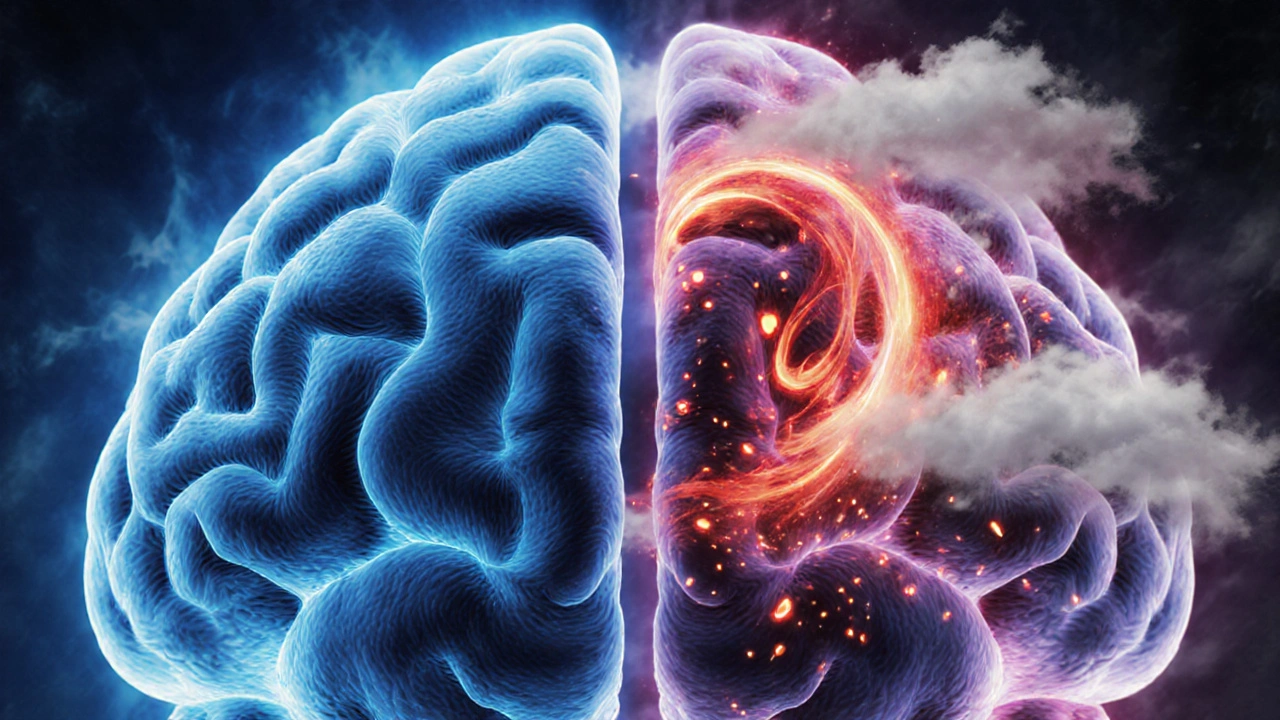Childhood Trauma Risk Assessment Tool
How This Tool Works
This assessment helps you understand your risk of developing depression based on childhood experiences and current protective factors. Your results will be based on evidence-based research from the National Institute of Mental Health and other leading studies.
Childhood Trauma Exposure
Current Protective Factors
Current Stressors
Ever wonder why some adults seem to carry a weight that never lifts, even when life looks perfect on the outside? The answer often traces back to experiences that happened before they even learned to read. Understanding the link helps you spot warning signs early and choose the right support.
Key Takeaways
- Early trauma reshapes the brain’s stress system, making depression more likely later.
- Both biological and psychological pathways play a role.
- Risk factors include chronic stress, low resilience, and co‑occurring anxiety.
- Protective factors such as supportive relationships and therapy can offset the risk.
- Effective treatment blends psychotherapy, medication, and lifestyle changes.
How childhood trauma refers to adverse experiences before age 18, such as abuse, neglect, or household dysfunction Sets Up Depression Later
When a child faces consistent fear or helplessness, their brain learns to expect danger. This chronic alarm state doesn’t switch off once the abuse ends; instead, it becomes a default mode that colors every adult experience. The result is a higher chance of feeling hopeless, losing interest, or withdrawing - the classic signs of Depression a mood disorder marked by persistent sadness, loss of pleasure, and impaired functioning in adulthood.
Biological Pathways: The Body’s Stress System
Research shows that trauma disrupts the hypothalamic‑pituitary‑adrenal (HPA axis the hormonal pathway that controls stress responses). Over time, cortisol - the stress hormone - stays elevated, damaging brain regions like the hippocampus that regulate mood and memory.
Another key player is neuroinflammation low‑grade inflammation in the brain that interferes with neurotransmitter function. Elevated inflammatory markers have been repeatedly linked to both trauma exposure and depressive episodes.

Psychological Mechanisms: Thought Patterns and Emotional Regulation
Beyond chemistry, trauma implants negative core beliefs - "I’m unlovable", "The world is unsafe" - that act like lenses, distorting everyday events into proof of those beliefs. This cognitive bias fuels rumination, a major predictor of depressive relapse.
Emotion regulation also suffers. Kids who never learned healthy ways to calm themselves may turn to avoidance or substance use as adults, both of which increase depressive risk.
Risk vs. Protective Factors
| Factor | Category | Impact on Depression Risk |
|---|---|---|
| Chronic Stress | Risk | High - amplifies HPA‑axis dysregulation |
| Co‑occurring Anxiety | Risk | Moderate - adds mental‑health burden |
| Low Social Support | Risk | High - removes buffering effect |
| Resilience Training | Protective | Strong - improves coping skills |
| Early Therapeutic Intervention | Protective | Strong - rewires negative schemas |
| Regular Physical Activity | Protective | Moderate - boosts endorphins and neurogenesis |
Notice how many of the protective items are things you can add to daily life. Even small changes can shift the balance.
Recognizing the Signs in Adults
Adults who have lived through trauma may not label their feelings as "depression". Look for these clues:
- Persistent low mood that doesn’t improve with positive events.
- Feelings of worthlessness tied to past experiences.
- Avoidance of relationships or situations that remind them of the trauma.
- Physical symptoms - headaches, gut issues, or chronic fatigue - without clear medical cause.
- Escalating substance use as a coping shortcut.

Treatment Approaches that Work
There’s no one‑size‑fits‑all plan, but the most successful strategies combine several layers.
Psychotherapy
Cognitive Behavioral Therapy (CBT) a structured talk therapy that challenges maladaptive thoughts and builds coping skills is the backbone for many adults. For trauma‑related depression, adding an exposure component (often called Trauma‑Focused CBT) helps process memories safely.
Eye Movement Desensitization and Reprocessing (EMDR a therapy that uses bilateral stimulation to re‑integrate traumatic memories) shows strong evidence for reducing both PTSD and depressive symptoms.
Medication
Selective Serotonin Reuptake Inhibitors (SSRIs first‑line antidepressants that increase serotonin availability) can alleviate mood swings and improve sleep, making therapy more effective. Always coordinate with a psychiatrist for dosage and monitoring.
Lifestyle and Support
- Exercise: 30 minutes of moderate activity most days boosts neurogenesis.
- Sleep hygiene: Consistent 7‑9 hour schedule stabilizes cortisol.
- Social connection: Peer‑support groups give a sense of belonging and reduce isolation.
- Mind‑body practices: Yoga or mindfulness lowers HPA‑axis reactivity.
Prevention and Early Intervention
Stopping the cycle before it reaches adulthood saves both emotional and economic costs. Schools and pediatric clinics can screen for adverse childhood experiences (ACEs) using a brief questionnaire. When scores are high, follow‑up steps include:
- Connecting families to community counseling.
- Teaching parents stress‑management techniques.
- Integrating resilience‑building curricula (e.g., problem‑solving, emotion‑labeling).
Even when trauma can’t be erased, early therapeutic work reduces the intensity of later depressive episodes by up to 40% according to a 2023 longitudinal study from the National Institute of Mental Health.
Frequently Asked Questions
Can adults develop depression without any childhood trauma?
Yes. Genetics, major life stressors, chronic illness, and substance use can all trigger depression independent of early experiences.
Is medication necessary if the root cause is trauma?
Medication isn’t mandatory, but it often eases symptoms enough for therapy to work more effectively. The decision should be personalized with a mental‑health professional.
How long does it take for therapy to reduce depressive symptoms?
Most people notice improvement after 8‑12 weekly sessions of evidence‑based therapy, though deeper trauma work can extend to 6‑12 months.
Can lifestyle changes alone reverse depression linked to childhood trauma?
Lifestyle shifts help, but severe cases usually require professional therapy or medication. Combining all approaches yields the best outcomes.
What are the signs that a child needs early mental‑health support?
Frequent nightmares, extreme irritability, sudden drops in school performance, or withdrawal from friends can all signal distress that warrants assessment.


kevin tarp
October 13, 2025 AT 13:59Childhood trauma creates a hidden blueprint that can echo into adulthood, often manifesting as persistent depression. When a child experiences neglect or abuse, their stress-response systems are calibrated to expect danger, even in safe environments. This hypervigilance exhausts the brain’s resources, leaving little capacity for joy or relaxation. Moreover, early trauma can impair the development of the prefrontal cortex, which is crucial for regulating emotions. The amygdala, on the other hand, may become overactive, triggering unnecessary fear responses. These neurobiological shifts are supported by a wealth of longitudinal studies linking adverse childhood experiences to later mood disorders. On a psychological level, trauma distorts self‑esteem, fostering beliefs that one is unworthy or unlovable. Such core beliefs become self‑fulfilling prophecies, reinforcing depressive thought patterns. Socially, individuals with unresolved trauma may struggle to trust others, limiting the formation of supportive relationships. Protective factors like strong social networks and therapy can buffer these effects, but they often require deliberate effort to cultivate. Regular exercise and consistent sleep further modulate neurochemical balances, offering modest relief. However, without addressing the root causes, these strategies may only provide temporary band‑aid. The assessment tool described in the post aims to quantify risk, but its true value lies in prompting introspection. Recognizing the link between early pain and present sorrow is the first step toward meaningful healing. Professional guidance can help rewire these maladaptive pathways, paving the way for lasting recovery.
ravi kumar
October 13, 2025 AT 14:30Reading this feels like a Western therapist trying to diagnose our people without understanding our cultural context. You talk about “protective factors” like therapy and exercise, but many in our community lack access or even the freedom to seek such help. The assessment tool is a nice idea, yet it reduces complex lived experiences to a few checkboxes. If we want real solutions, we must address systemic oppression first, not just individual coping mechanisms.
SandraAnn Clark
October 13, 2025 AT 15:20Well, it's another article telling us to “talk about our feelings”. Sure, sounds nice, but does it actually fix anything? Probably not.
Rex Wang
October 13, 2025 AT 16:26Wow-this is a solid breakdown of how early trauma can shape adult mood; really helpful!
mark Lapardin
October 13, 2025 AT 17:16The neuroendocrine dysregulation highlighted aligns with the psychoneuroimmunology framework, suggesting that interventions targeting HPA axis modulation could synergize with cognitive‑behavioral strategies for depression mitigation.
Barry Singleton
October 13, 2025 AT 18:06Statistically, the prevalence of ACEs correlates with a 1.5‑fold increase in major depressive episodes, yet the article glosses over confounding variables like socioeconomic status. This omission undermines its clinical applicability.
Javier Garcia
October 13, 2025 AT 18:56Good points, but missing data on longitudinal outcomes.
christian quituisaca
October 13, 2025 AT 19:46🌟 Absolutely love how this piece blends science with compassion! It reminds us that healing isn’t a one‑size‑fits‑all journey, and that each supportive habit-whether a morning jog or a midnight chat with a friend-adds a splash of color to the canvas of recovery.
Donnella Creppel
October 13, 2025 AT 20:36Honestly, this article is as thrilling as watching paint dry-except it tries too hard to sound "deep". The prose is riddled with buzzwords, yet it fails to truly **engage** the reader; it's all surface‑level fluff! Moreover, the risk‑assessment tool, while shiny, seems more like a gimmick than a scientifically validated instrument-definately not something to rely on without further peer review. If you truly want to help, stop selling snake‑oil solutions and start listening to what survivors actually **receive** from their communities!
Jarod Wooden
October 13, 2025 AT 21:26The human psyche is a battlefield where ancient traumas wage war against modern aspirations; one cannot simply "exercise away" deep‑seated anguish. True liberation demands confronting the shadow self, deconstructing the myth of the autonomous individual, and embracing collective healing rituals. Anything less is a hollow promise packaged in therapist-speak.
lee charlie
October 13, 2025 AT 22:16I hear you-building support networks really does make a difference. Keep sharing these resources, it helps.
KIRAN nadarla
October 13, 2025 AT 23:06Oh wow! This article hits the nail on the head, exposing the silent scream of our childhood scars. It's like unveiling a hidden movie reel that plays on repeat in our minds, looping the same painful scenes over and over. The assessment tool? Pure gold! It gives us a map to navigate the labyrinth of our own past. I can already feel the empowerment bubbling up, like a storm ready to break free!
Adele Joablife
October 13, 2025 AT 23:56Sounds like a step in the right direction.